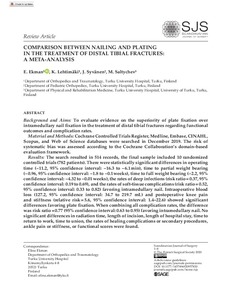Comparison Between Nailing and Plating in the Treatment of Distal Tibial Fractures: A Meta-Analysis
M. Saltychev; E. Ekman; K. Lehtimäki; J. Syvänen
Comparison Between Nailing and Plating in the Treatment of Distal Tibial Fractures: A Meta-Analysis
M. Saltychev
E. Ekman
K. Lehtimäki
J. Syvänen
SAGE PUBLICATIONS LTD
Julkaisun pysyvä osoite on:
https://urn.fi/URN:NBN:fi-fe2021042827576
https://urn.fi/URN:NBN:fi-fe2021042827576
Tiivistelmä
Background and Aims: To evaluate evidence on the superiority of plate fixation over intramedullary nail fixation in the treatment of distal tibial fractures regarding functional outcomes and complication rates.
Material and Methods: Cochrane Controlled Trials Register, Medline, Embase, CINAHL, Scopus, and Web of Science databases were searched in December 2019. The risk of systematic bias was assessed according to the Cochrane Collaboration's domain-based evaluation framework.
Results: The search resulted in 514 records, the final sample included 10 randomized controlled trials (782 patients). There were statistically significant differences in operating time (-11.2, 95% confidence interval: -16.3 to -6.1 min), time to partial weight bearing (-0.96, 95% confidence interval: -1.8 to -0.1 weeks), time to full weight bearing (-2.2, 95% confidence interval: -4.32 to -0.01 weeks), the rates of deep infections (risk ratio = 0.37, 95% confidence interval: 0.19 to 0.69), and the rates of soft-tissue complications (risk ratio = 0.52, 95% confidence interval: 0.33 to 0.82) favoring intramedullary nail. Intraoperative blood loss (127.2, 95% confidence interval: 34.7 to 219.7 mL) and postoperative knee pain and stiffness (relative risk = 5.6, 95% confidence interval: 1.4-22.6) showed significant differences favoring plate fixation. When combining all complication rates, the difference was risk ratio = 0.77 (95% confidence interval: 0.63 to 0.95) favoring intramedullary nail. No significant differences in radiation time, length of incision, length of hospital stay, time to return to work, time to union, the rates of healing complications or secondary procedures, ankle pain or stiffness, or functional scores were found.
Conclusion: This meta-analysis suggests that intramedullary nail might be slightly superior in reducing postoperative complications and result in slightly faster healing when compared to plate fixation.
Kokoelmat
- Rinnakkaistallenteet [27094]
